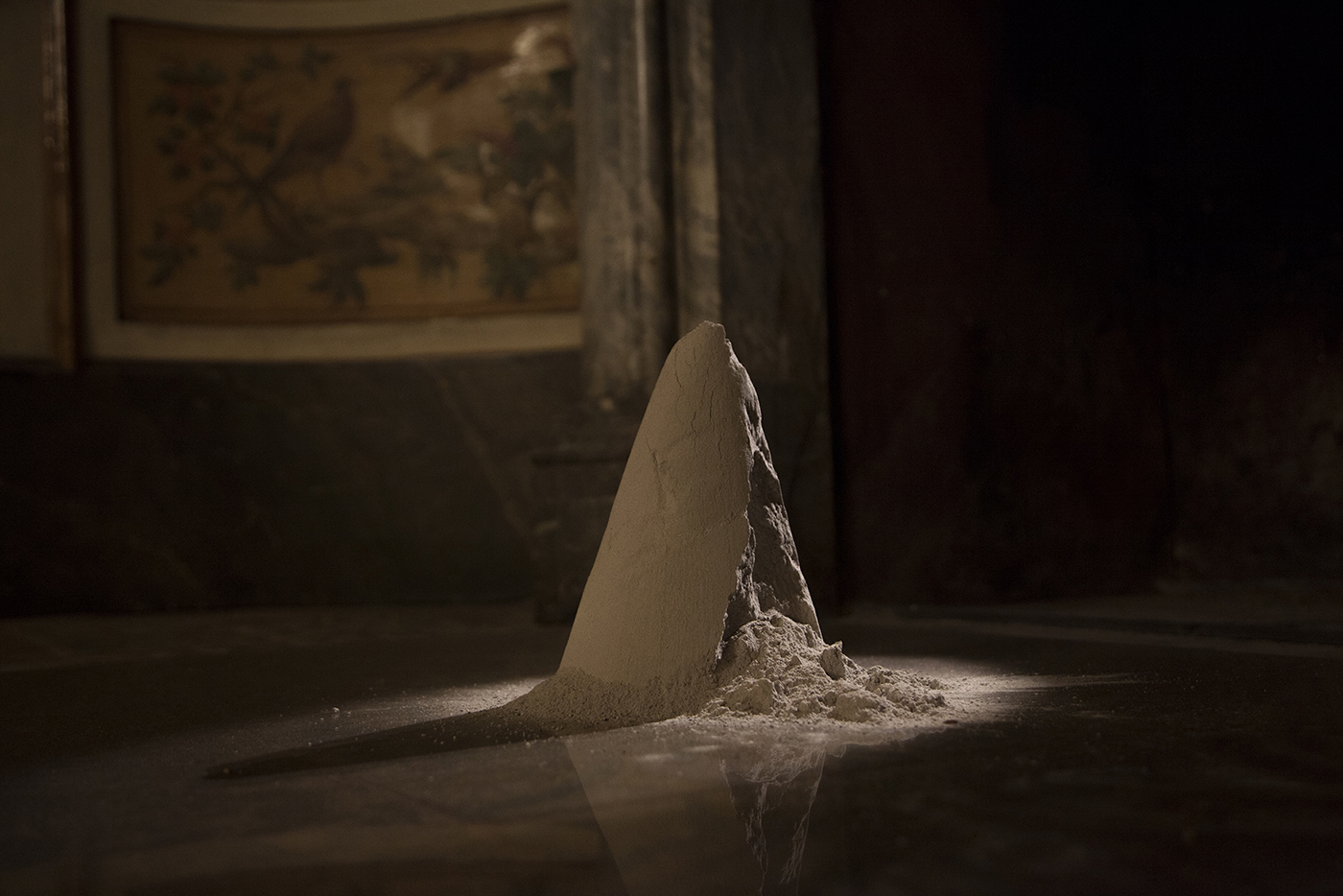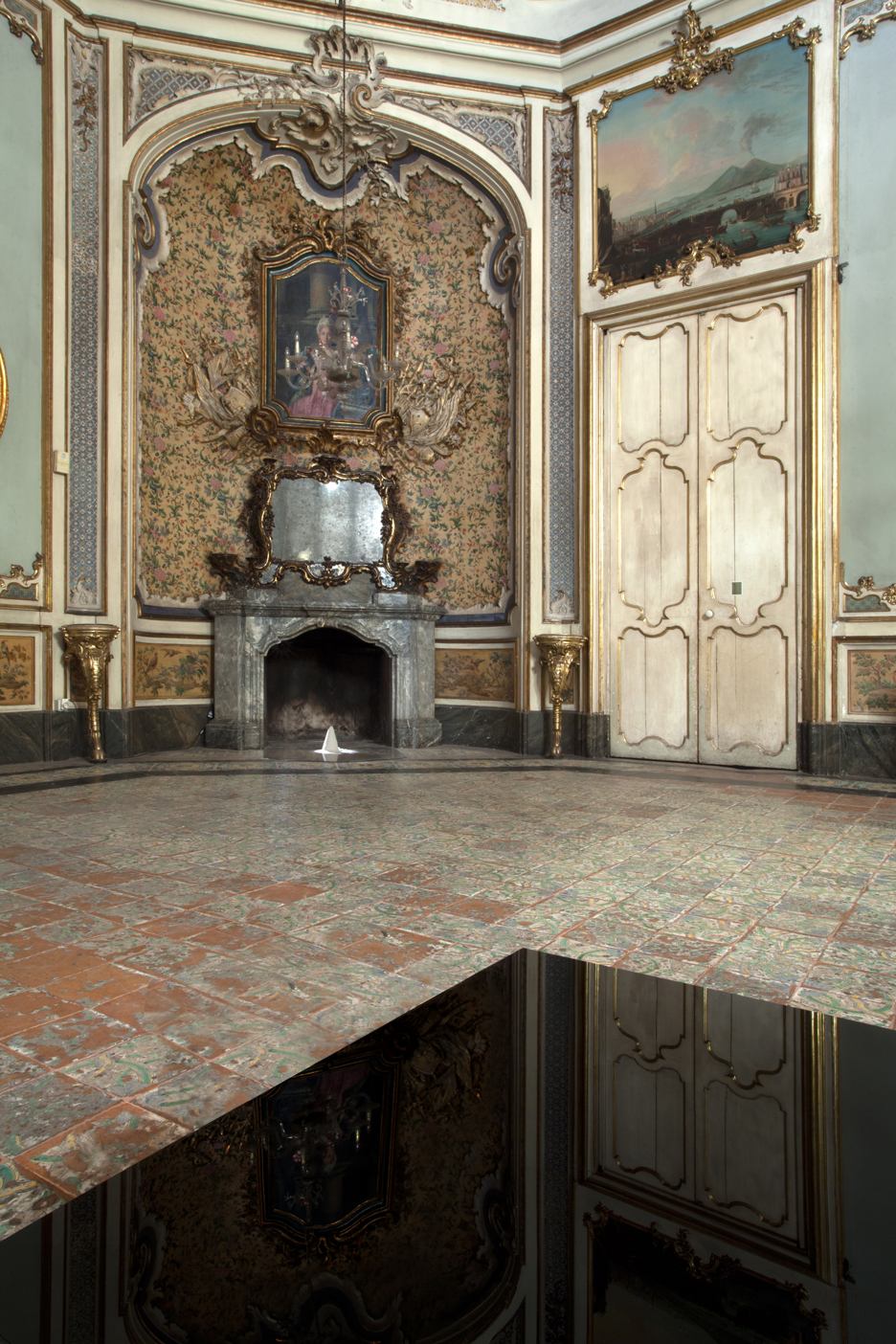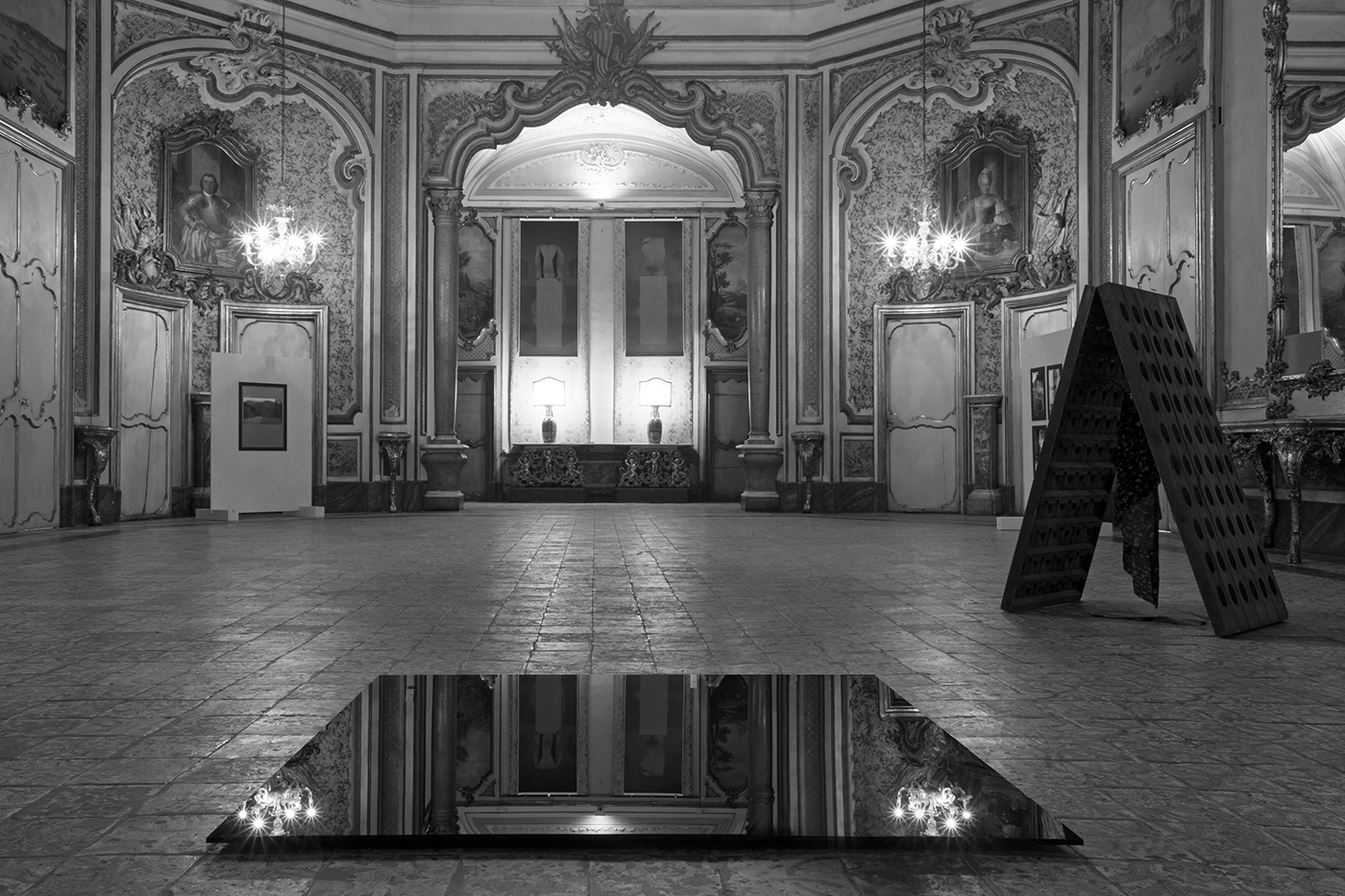Space, Contexts,
Habitats.
Goldsmiths University of London presents:
Space, Contexts, Habitats. Palazzo Biscari, Catania 2015
Curated by Costanze Honsel, Pietro Scammacca and Virginia Simonazzi.
POETIC | SPACESBAROQUE | CONTEXTSDIFFERENTIAL | HABITATS
Wood Roberdeau
‘…artifice was considered by Des Esseintes to be the distinctive mark of human genius. Nature, he used to say, has had her day…’
The protagonist of Joris-Karl Huysmans’s seminal novel Against Nature takes a late nineteenth century Baudelarian view of his surroundings. As a solipsistic orchestrator of good taste, Des Esseintes reacts to a panoply of material encounters, from a metaphysical understanding of great works of literature and masterful paintings to a psychosomatic appreciation of colours, fragrances, and even the glint of gemstones encrusted on the gilded shell of a live tortoise (obtained to complement the hues of his Oriental carpet). Quintessentially the nesting collector, he guides the reader on a private tour of his utterly self-indulgent world; significantly, this world is framed by the house he has designed and the contents within. Dwelling-as-decadence is a theme that allows fiction to simultaneously satirize aristocratic obsessions and celebrate common pleasures; it links humanist philosophy to the sensuality of everyday life.
Palazzo Biscari might be construed as a similar site of personal, artistic expression. Ignazio, fifth Prince of Biscari, philanthropically contributed to Catania’s visual culture within the taxonomic spirit of the eighteenth century by amassing his own collection through archaeological expeditions and architectural flourishes. Such a romantic stance towards one’s domicile resonates with Gaston Bachelard’s ruminative endeavour to ‘show that the house is one of the greatest powers of integration for the thoughts, memories and dreams of mankind.’ Indeed, the splendour of this building effectively encourages an understanding of the poetics of space as anthropocentric – the palazzo truly manifested from a Baroque Weltanshauung or ‘worldview’. In his reading of Leibniz, Gilles Deleuze considers the theoretical implications for interiority, observing that ‘for ages there have been places where what is seen is inside: a cell, a sacristy, a crypt, a church, a theatre, a study, or a print room.
The Baroque invests in all of these places in order to extract from them power and glory.’ Historically, this ornamental style has been invested with properties that establish a clear division between interior and exterior, private and public, or, ‘domesticity’ and ‘environment’. Sunlight, for example, was often bent through high windows in order to illuminate a domed room without granting full visibility of the grounds beyond. For Deleuze, put simply, the differential relationship between the façade (public, lower level) and the chamber (private, upper level) of a baroque house typifies a philosophical folding – that of the macrocosm into the microcosm or the outside (‘cosmos’) with the inside (‘mundus’). On the one hand, spatially charged Baroque epistemology placed man at the centre of his conceivable universe, whilst paradoxically distinguishing Nature-as-other and thereby privileging external critique through interiority and illusion (symbolized by the camera obscura). On the other hand, this reciprocity between subject and object connotes a continual development of consciousness.
Thinking ‘context’ as a site-specific Baroque fold that rightfully complicates and extends a ‘being-with’ should be followed by a notion of ‘habitat’ as a localizable zone of interactivity. Rural and urban landscapes are physically, politically, and ecologically negotiable; they are in constant states of (de)construction and (de)compartmentalization. Concerning the production of space, Henri Lefebvre has identified three critical categories: ‘absolute space’ refers to pre-modern sites of ritual and embodiment where the political overtook what was natural; ‘abstract space’ emerges as a condition of modernity and capital that disconnects labour from place; ‘differential space’ is proposed as a necessary re-articulation of space after its homogenous abstraction; it will ‘restore unity to…the functions, elements, and moments of social practice.’ On that note, it would seem that contemporary visual works that engage with questions of scale, perspective, performance, architecture, and the lived environment in response to such a rich history can only push towards the activation of this third spatial paradigm – folding, inverting, delimiting.
View show, Palazzo Biscari, Catania — April 2015
Pas-Tout, view show, Palazzo Biscari, Catania — April 2015

Particular pigment view show, Palazzo Biscari, Catania — April 2015
Contexts by Pietro Scammacca
What is context? How is context created? What is the relationship between context and art?
As soon as art is exhibited, it becomes part of a context.
For Spaces, Contexts, Habitats exposing works of art in the beautiful rooms of Palazzo Biscari becomes an important curatorial choice as well as a self-imposed obstacle. Such a milieu is of course not predisposed towards the exhibition of works of art, even its walls must remain untouched by curators. Why then, this choice of place?
Nowadays the curator needs to develop a consciousness of space, understand that our ways of perceiving art are influenced by the context in which we see them. This analysis can also be extended to the act of framing art. Putting a frame on a picture also subjects the object to undergo a certain contextualization and a constructed experience of it.
The second room of the exhibition shows black and white images of London’s colossal buildings. These cold and brut photographs diverge the architecture in which they are themselves exhibited: the warm and joyful Sicilian Baroque. The Sicilian Baroque frames these photographs and contrasts their content; the container and the contained are in conflict.
This clash of colours and aesthetics is meant to place a comment not only upon the evolution of architecture but also on its potential overwhelming aspect and the influences that it can have on our behaviour and experience of art. Take for example the classical museum with its neoclassical architectural setting. Its context, constructed by history and its elevated social status, forces us to monitor our own behaviour and look at art from a distance. An objective mode of perceiving art is encouraged –we look at it chronologically and follow a pre- determined path. Visitors become passive spectators instead of active participants. As Carol Duncan has articulated, these places are secular temples in which the visitors practice a ritual, a “structured experience”.
This is not to say that the Sicilian Baroque becomes the optimal spatial setting for disrupting this ritual, it too entails a strong effect on the spectator. In order to disrupt this ritual, innovative curatorial gestures are needed. In this exhibition, we find ourselves face to face with the philosophy of curating context. We understand that the role of the curator is not to simply to hang artworks on walls, but to disrupt restrictions and limitations, to open new possibilities and expand the gallery space setting.
Habitats by Virginia Simonazzi
Human beings and their habitats are interconnected within a deep and essential relationship. Inhabiting a place, a space, inevitably entails the fact that such places and spaces affect our behaviours; at the same time, these spaces are affected by our presence, assuming the shapes and colours that characterise our personalities. Inhabiting a space means to make of that space our corner of the world. Human beings have always felt, and always will feel, a deep desire to find, research, or create, their own habitat, a place where to feel comfortable and safe from the world surrounding them. Inhabiting entails security and comfort; inhabiting is, ultimately, synonym of feeling at home.
This comfortable feeling, within a reality that entails constant changings, technology and globalised realities, has become a secondary need for the modern man. The awareness that the world belongs to us, often overcomes the simplicity of basic needs. Habitats, one of the most essential elements that belong to human possibilities, have become overlooked or forgotten spaces – superfluous details within our frenetic lives. Spaces, Contexts, Habitats, aims to detour and dismiss this tendency. The images portraying places and spaces gathered at Palazzo Biscari, are essentially intended to remind us of the fact that every space we inhabit represents a fundamental component of our everyday lives. The photographs presented by Culiere, Ingrassia, Mahboubian and Bignon, enigmatically show different kinds of habitats, details that we often overlook and forget. Such images require the viewer to directly engage with them in order to be understood and contextualised.
Within the imposing rooms of the baroque palace, now frame, space and context, of photographs, video and performance, we are invited to take part to a chromatic and ideological dialogue, displacing yet enchanting. Portraits of human bodies coloured of a vivid red, photographs of hidden details of the palace, colourful patterns, all of these images capture details of spaces that we ordinary encounter and often neglect. The contrast between images and the space they inhabit – the palace – becomes strong and visible, almost graspable. Amongst the numerous narratives that flourish within the rooms of Palazzo Biscari, where contemplative images and cryptic ones share the same breathing environment, one of the deepest and most significant reflections that we come face to face with, is, perhaps, a banal yet meaningful thought; habitat is here presented as an encounter of enigma and colours, bodies and space, nature and architecture. The notion of habitat becomes an open question; what does the relationship between us and our surround- ings, humans and habitats, consists of? What does it mean, today, to inhabit a space? What is a habitat?
What the artists are trying to show and tell us, is perhaps something we were already familiar with, but we often tend to forget; within a reality that constantly overwhelms us with images, messages and stimuli, our habitat – our corner of the world – is not a physical space, but rather a mental, imaginary one. The notion of habitat today has undergone a variety of different aspects; amongst which, the identification of it with non-physical spaces; habitats represent sensations that results from a deep reflection upon every detail that inhabits our everyday lives, often the most hidden and meaningless ones. Habitats means thinking and rethinking of us within our surroundings.
Spaces by Constanze Honsel
The first room of the exhibition focuses on the notion of Spaces and photographic works of nature and landscapes. Ironically, the consistent quality of spaces is their ephemerality. Any space has the ability to change, whether this is seen in natural or artificial spaces, such as Palazzo Biscari. The Palace’s presence in Catania represents a constant dwelling space, a place of tradition and history. It is therefore the perfect location for an artistic exploration and contemplation of spaces. The poetics of spaces can be assumed in interiors and exteriors acting as places of retreat or gathering. The photographic landscape images and natural environments are dialectically opposed to the interiority of the palace rooms. The visitor is confronted by the contrast of the lavish baroque rooms and the contemporary photographic works. This illustrates the powerful tension between the old palace interior and the contemporary art, bringing together past aesthetic values with present one’s.
I will exemplify the exhibition’s particular engagement with natural spaces by looking closer at three of the represented artists. Spectators are faced with untraditional curatorial choices such as the presentation of Melissa Magnuson’s photograph Ice Cave as a large-scale print on the floor. The path of orientation is interrupted and contemplation about the expectations of photographic display are encouraged. The work is exposed to the possibility of destruction by visitors walking close to its parameters, which mimics the contemporary issues of human threats to nature. It seems that when it comes to acting within natural environments, we have lost our sense of behavioural rules. Nature is often no longer respected or feared as humans embark on a systematic exploitation of natural resources that threaten to destroy untouched wildernesses. The exhibition relocates our attention to the beauty of the natural world refram- ing traditional landscape photography. Ice Cave illustrates the dynamic and ephemeral arctic landscape of Iceland. Placed on the floor of the room one senses images of melted ice as the blue spectrum of colours diffuse in front of one’s feet. Daniele Fummo also breaks with tradition by framing his photographs in a portrait format, which attributes landscapes with a human quality. Here the atmosphere opposes the dynamic of Ice Cave as Fummo captures the isolation and tranquillity of Italian landscape sceneries. The landscape is devoid of human subjects although traces of human intervention are seen in the farmed land at the foot of the mountain. Liam Hughes similarly plays with the untraditional framing of landscapes. He frames his photograph on a powerful red background that takes up the manipulation of the red tinted photograph itself. The artificial altering of a natural scene is boldly elucidated with the emotive and dominant red colouring. This subtends the elaborate romantic baroque palace room, which is similarly artificially constructed by human hands. The artists merge a sense of seclusion of nature with an underlying invasion of human intervention. Natural spaces are reframed in the exhibition through the dialectic of the extravagant palace atmosphere, the experience of natural landscapes through contemporary photography and the role and place of the human subject within those spaces.




